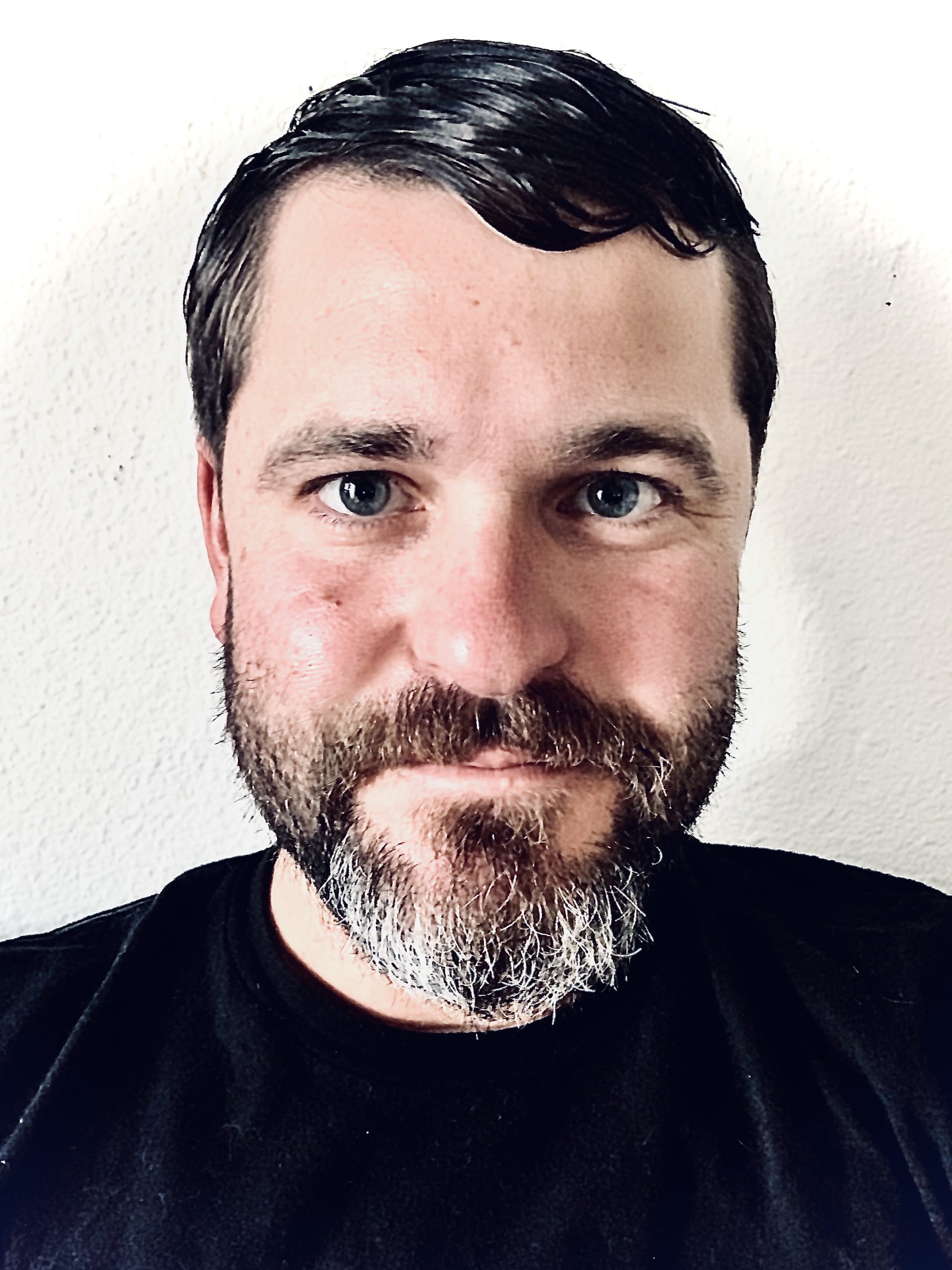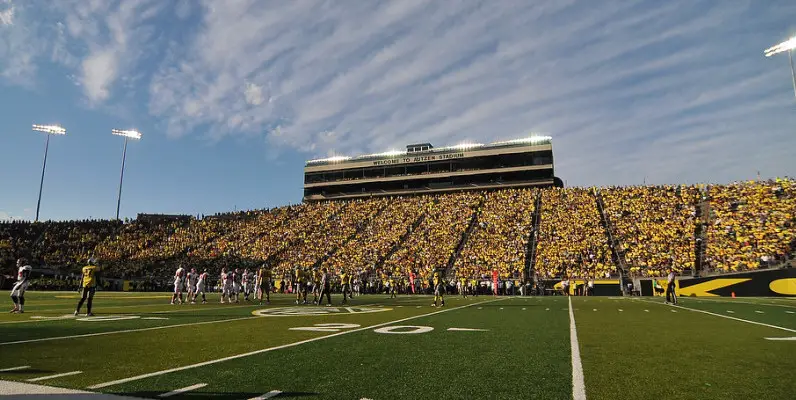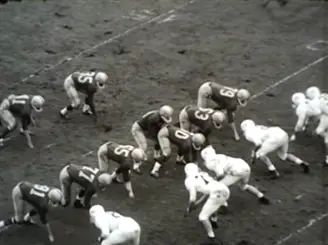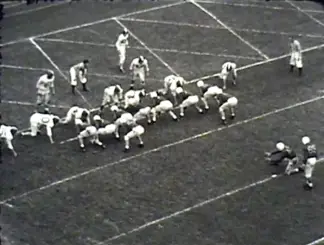The oak tree has long been a symbol of strength, endurance, valor and accomplishment. These distinguished attributes signify the separation of the ordinary from the exceptional. A century of Oregon football has produced a grove of tall firs and mighty oaks, individuals whose roots vibrantly pulse beneath a lavish wildwood of virtue.

Mark Helfrich’s “Men of Oregon” recognizes a century old tradition of strong individual character, sportsmanship, and athleticism.
The 2014 Oregon football team was just the latest embodiment of the fortitude of the oak, led by Heisman Trophy winner Marcus Mariota and surrounded by men of robust character, strong will, football acumen, and determination. They will be remembered for their focus, unity, commitment, sportsmanship, and relentless preparation in their pursuit of excellence.
Oregon Head Coach Mark Helfrich has repeatedly referred to seeking and developing “Men of Oregon” by recruiting resilient young men of both exemplary physical and moral fitness to best represent the school, community, and program.
Helfrich’s aphorism encapsulates more than one hundred years of Oregon football, honoring willpower, teamwork, and unbreakable heart. While this standard appears relatively new, it is Oregon’s longest tradition. And the origin of the “mighty oak” was forged in the furnace of war nearly 65 years ago.
In 1941, a 6’4″ 225 Brad Ecklund from Milwaukee High School joined Tex Oliver‘s Oregon football team. At the time, a man of this size and stature was an intimidating figure with an unbreakable resolve. His friends, teammates, and fellow soldiers called him “Whitie.” The press accurately dubbed him “the indestructible giant” and “the mighty oak.”
Inducted into both the NCAA College Football Hall of Fame and NFL Hall of Fame, the four sport star athlete was confirmed unequivocally as the greatest center to ever play Oregon football.
At Milwaukee High, Ecklund excelled in baseball, football, track, and basketball. After graduation, Ecklund accepted a full ride scholarship to play football at the University of Oregon. Oliver saw the size of Ecklund and immediately planted the “mighty oak” at center on the offensive line.
After 1941, the U.S. ramped up its involvement in World War II, sending droves of young American men to fight the Axis powers, either through military conscription or voluntary enrollment. After Ecklund started every game as both center and linebacker in the ’41 season, the multi-talented big man flunked out of college and opted to join the U.S. Marine Corps.
The fiercely competitive ”Whitie” refused to remain idle in the USMC and took up boxing, eventually becoming the Marine Corps Golden Glove Champion. Ecklund also played for the USMC Naval Air Raiders football team for two years while stationed in Jacksonville, Florida before his inevitable deployment to the South Pacific.
Ecklund earned the rank of sergeant and fought in the Pacific theater, island hopping and engaging in battle after battle, including the Battle of Okinawa, the largest amphibious assault in the Pacific War in WW II.
Battleship USS West Virginia giving fire support to U.S. soldiers at the Battle of Okinawa, 1945 pic.twitter.com/uA9ZDvwvX4
— OnThisDay & Facts (@NotableHistory) January 12, 2015
For four years, Ecklund’s unit served as a part of the second wave of Marines, often washing onto shore only to encounter the destruction of his Semper Fi brothers in gruesome and inexplicably violent spectacles. “I was in the second wave. It was the guys in the first wave who got their butts shot up,” Ecklund told the Register Guard. A year after V-J day, Ecklund, along with his wife and new son, returned to Eugene with hopes for obtaining a college degree. The young veteran, husband, and father was nervous that the University of Oregon wouldn’t let him return to school.
V-J Day celebrations on August 14, 1945. The unseen photographs by Ezra Stoller. http://t.co/xex8kUGl7K pic.twitter.com/IPiqOPPgVK — Photo Booth (@tnyphotobooth) February 25, 2015
However, after the war Whitie’s four years of military service nullified his previous academic shortcomings and Oregon afforded the star another shot to finish what he started. A determined Ecklund followed through with his second chance, graduating with a B average.
Ecklund wasn’t the only WWII veteran to return home eager to play football for new Oregon head coach Jim Aiken. Stalwarts such as John McKay, Norm Van Brocklin, Jake Leicht, George Bell, and Woodley Lewis made for an intimidating Oregon roster. These seasoned men were out for football glory, but not in the traditional pom-pom pep rally sense.
Aiken’s Webfoots were an odd mash-up of veterans, transfers, and athletes that somehow worked harmoniously as interchangeable parts, including African-American kicker/offensive and defensive lineman Chet Daniels, a non-veteran who considered that team a “fine group of fellows.”
“It wasn’t a rah-rah type thing. We never needed a pep talk. How do you get a guy who’s 24 years old and fought in the war hyped about a football game?” Daniels told the Register Guard.
In 1948, this fearless motley crew adopted Aiken’s T-formation, benefitting from the strong and accurate arm of the Flying Dutchman, quarterback Norm Van Brocklin. The Webfoots went 9-1, tying California in the PCC (Pacific Coast Conference), leading the Ducks to their first ever Cotton Bowl appearance against Southern Methodist University.
Despite losing to SMU and the 1948 Heisman Trophy winner, running back Doak Walker, Aiken’s squad surpassed everyone’s expectations, a victory that carried much more weight than any trophy. Oregon’s All-American center and Van Brocklin both received MVP honors in the Cotton Bowl game.
These guys were a different type of tough. Ecklund played both sides of the line for an average of fifty minutes a game. The trenches of college football hardly resembled the ravages of Pacific and European warfare. The combination of military-type camaraderie and outstanding athleticism later earned him the University of Oregon’s Lineman of the Century.
“I think because we were all veterans, we were very dedicated. We’d fought for our country, we had that esprit d’ corps and not one guy on that team was a bum. We weren’t all great players, but we’d always back each other up, and when we went into battle, we knew what it meant to be in the trenches,” Ecklund said.
For Ecklund and his veterans counterparts, the experience of war successfully translated to the gridiron. Perhaps the greatness of the ’48 Oregon football team was just a peculiar circumstance, a harmonious culmination of people particular to a specific time. However, it’s hard to imagine that the landmark 1948 season was merely a coincidence
There is a national misconception that Oregon football lacks tradition. Certainly, the many decades of Oregon football can be described as a mixed bag of high marks and low points. The “Men of Oregon” have been underdogs, fiery competitors, and innovators who carried the tradition of unorthodoxy on their backs. And win or lose, men from Ecklund to Mariota proudly stand amongst the mighty oaks of Oregon football.
Top photo by Kevin Cline

Jordan is a lifelong Duck fan currently living in San Diego. Jordan graduated from The Evergreen State College in Olympia, Washington, after serving a prestigious fellowship with the Washington State House of Representatives. Upon graduation, he worked as an English language teaching assistant for the Spanish Ministry of Education’s Ambassadorial Program in Monforte de Lemos, Spain. Jordan has worked as a journalist, writer, and editor in Oregon, Washington, Montana, and California, covering a wide range of topics, including sports, local politics, and crime. He is VERY excited to be writing about his beloved Oregon Ducks.



